|
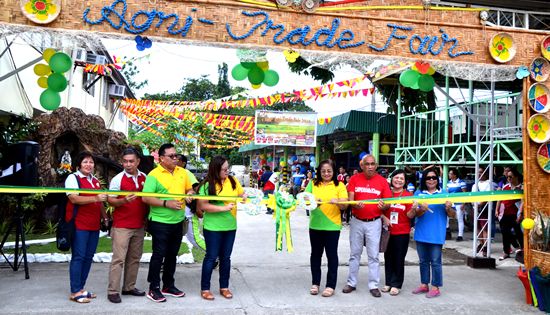
DAR-8
Regional Director Sheila Enciso (4th from left), Assistant
Regional Directors Ma Fe Malinao (4th from right) and Ismael
Aya-ay (3rd from left) cut the ceremonial ribbon to formally
open the mini-agraryo trade fair at the DAR Regional Office
compound. With them are DAR provincial officials (from left)
Teresita Alde (PARPO-I, Eastern Samar), Gilberto Apilado (PARPO-II,
Eastern Samar), Renato Badilla (PARPO-II, Leyte), Paulina
Canales (PARPO-I, Leyte) and Elisea Orapa (PARPO-II,
Southern Leyte. |
DAR commemorates
30 years of CARP, opens agraryo-trade fair
By
JOSE ALSMITH L. SORIA
June 13, 2018
TACLOBAN CITY – A
mini-agraryo-trade fair was opened on Monday morning at the
Department of Agrarian Reform Regional Office compound in this city
as the said agency started a four-day celebration in commemoration
of the 30 years of implementation of the Comprehensive Agrarian
Reform Program (CARP) in the county.
The trade fair highlights
the celebration showcasing the growth of the agrarian reform
beneficiaries (ARBs) from ordinary tillers to enterprising ARB
organizations (ARBOs).
All five DAR provincial
offices in Eastern Visayas were provided a booth for ARBOs products
ranging from agricultural to handicrafts and processed foods.
Regional Director Sheila
Enciso disclosed that DAR has provided more than 219,000 ARBs
throughout the region with certificates of land-ownership award (CLOAs),
while more than 413 ARBOs were organized into associations or
cooperatives during the 30 years of CARP implementation.
Meanwhile, Assistant
Regional Director for Program Beneficiaries Development (PBD) Ismael
Aya-ay likewise disclosed that DAR has provided ARBs through the
years with various support services such as infrastructures, common
service facilities, trainings and facilitate too in availing of
credit assistance.
He further disclosed that
four processed food products produced by ARBOs in Leyte, Samar and
Eastern Samar can now be sold on a larger scale after obtaining
recently a license to operate from the Food and Drug Administration
(FDA).
These are: “Banana Chips”
by Omaganhan Farmers Multi-Purpose Cooperative in Tabango, Leyte;
“Imbotido” by LIBERCON Multi-Purpose Cooperative in Hilongos, Leyte;
“Pancit Canton” (squash and malunggay flavors) produced by San Roque
Farmers Association in Daram, Samar; and “Cassava Chips” (sweet
blend and garlic flavors) by ESEP ARC Cooperative in Salcedo,
Eastern Samar.
On June 10, 1988, then
President Corazon Aquino signed Republic Act No. 6657, otherwise
known as the Comprehensive Agrarian Reform Law (CARL) to look after
the welfare of the landless farmers and farmworkers to receive the
highest consideration to promote social justice and to move the
nation towards sound rural development and industrialization.
To commemorate the 30
years of implementation, DAR-8 kicked-off the four-day celebration
thru a motorcade around the city on Monday morning and will end on
Thursday by recognizing the support and contribution of various
government agencies and non-government organizations during the past
three decades.
This year’s celebration
theme is “CARP@30: DARe2change Pagbabalik tanaw sa 3 dekada ng
repormang agraryo patungo sa ikalawang yugto ng pagbabago”.
|
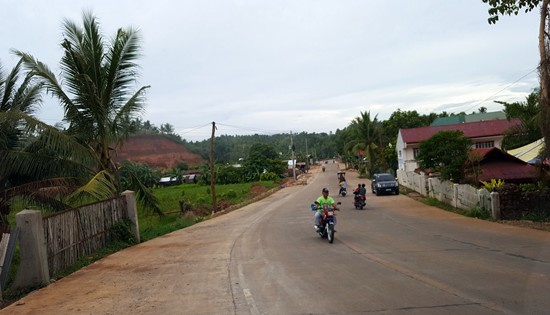
Widening
of Biliran Circumferential Road (Brgy. Pulang Bato Section)
is on-going with 70% accomplishment as of May 31, 2018 along
with the other sections in Bilwang - Burabod, Mapuyo and
Kaulanguhan. This project has a contract amount of P125M
under 2017 implementation. It is target to be completed on
June 30, 2018. |
DPWH-Biliran
DEO’s 2017 projects is on-going with 74.16% accomplishment
Press Release
June 13, 2018
NAVAL, Biliran –
David P. Adongay Jr., District Engineer of Biliran District
Engineering Office is rushing for the completion of on-going 2017
projects.
As of May 31, 2018, the
Department of Public Works and Highways (DPWH)- Biliran District
Engineering Office has an accomplishment of 74.16% for 57 total
projects under year 2017 infrastructure program.
Out of the 57 projects, 52
are completed while five projects with an allocation of P50M and
above are still on-going.
Spilled-over projects of
2017 includes widening projects, rehabilitation of access road
leading to Naval port, and Rehabilitations of Slope Protection
Structures.
Having a negative slippage
of 5.73% as of May 31, 2018, Adongay orders project engineers to
closely monitor on the projects for fast completion.
“Hindi ibig sabihin na
pag’pinabibilis natin ang trabaho ay dapat ma compromise ang quality
ng project, dapat nandoon pa rin yung quality,” Adongay said.
Meanwhile, Adongay informs
that starting 2019, the department will be implementing a
“cash-based appropriation” policy. This means that contractors’
payment can only be done within a 15-month period.
“From the year the project
was implemented and completed, contracts delivered at the end of the
year can be paid during the 3-month Extended Payment Period (EPP) or
from month of January to March only of the following year,” Adongay
said. This is in contrast from the present policy of the DPWH which
is the “obligation-based appropriations” wherein the inspection,
verification, and payment for contractors will run 24 months and
beyond.
“This year 2018 is the
transition period for contractors to be cognizant of the shift,” he
said.
According to Adongay, the
shift will ensure that agencies will focus on executing the budget
of the current year and not from prior years. This is part of
President Rodrigo Dutere’s Build, Build, and Build Program.
On the
rehabilitation of Boracay
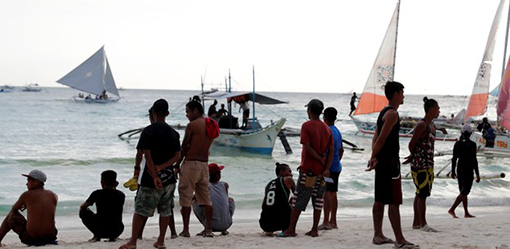
By
NDFP RWC-SER
June 13, 2018
MANILA – The
National Democratic Front of the Philippines Reciprocal Working
Committee on Social and Economic Reforms (NDFP RWC-SER) said the
Government of the Philippines (GRP) promise to carry out agrarian
reform program in Boracay must start with free land distribution to
farmers and indigenous people in the island.
The free land distribution
component of a new agrarian reform program was agreed by both the
NDFP and GRP at the RWCs-SER in the previous rounds of the peace
talks.
After free land
distribution, Boracay farmers should be given sufficient support
services ranging from short to long-term assistance to aid them in
developing and making the land productive for the local and national
economy, the NDFP RWC-SER said, in response to President Duterte's
remark that Boracay natives should sell their lands to big
businesses.
Agrarian reform imbued
with the spirit of social justice, indigenous peoples' rights, and
working people's rights is the Filipino people's demand. We
challenge the GRP to fast track the negotiations on CASER as when we
resume formal talks this month, said Julie de Lima, chairperson of
the NDFP RWC-SER.
Both parties must iron out
the few remaining contentious issues and come out with a common
draft for the Agrarian reform and Rural Development (ARRD) and
National Industrialization and Economic Development (NIED) of the
Comprehensive Agreement on Socio-Economic Reforms (CASER)," De Lima
said.
She added that the Boracay
case falls squarely within the ambit of agrarian reform and rural
development because the GRP itself has classified a big bulk of
lands at issue either as agricultural or suitable for agriculture.
A new and truly
redistributive land reform program is necessary, as it would pave
the way for a truly just and equitable agrarian reform to benefit
the most qualified beneficiaries in Boracay ”those who are actually
tilling the land, or ready to till it, or to work the land in other
productive ways such as agro-forestry, fishery, small-scale food
processing, and the like. The Ati community, including those that
have been displaced but willing to return, should be given priority.
De Lima also stated that the issue of environmental justice must be
served in implementing an agrarian reform program in Boracay.
In the last four decades,
the environmental situation of Boracay has immensely deteriorated.
The GRP agencies' aggressive and obsessive drive for tourist
revenues has resulted in grievous human rights violations such as
the displacement of its original occupants, the Ati community,
including the killing of tribal leader Dexter Condez.
De Lima noted that there
are various applicable provisions in the NDFP's CASER draft that the
GRP may find enlightening. The rehabilitation of Boracay can, in
fact, serve as a testing ground for the provisions of a signed
agreement on agrarian reform and rural development.
NUSP: Limited
slots, fees collection hound first year of free education
Press Release
June 13, 2018
QUEZON CITY – The
National Union of Students of the Philippines (NUSP), a nationwide
alliance of student councils, condemns the Duterte administration’s
maneuvers to limit the beneficiaries of free higher education.
Limited slots, facilities
in public schools
“Not all Filipino youth
will benefit from free education because government policy pushes
state universities and colleges (SUCs) to limit the slots available
for enrollees. Worse, the Duterte administration does not intend to
improve campus facilities so that more students can be
accommodated,” said NUSP National Spokesperson Mark VIncent Lim.
In Bulacan State
University, the country’s third largest SUC, only 10,000 out of the
22,000 students who took the entrance exam will be accepted.
Students and their parents have trooped into student council offices
to seek for help regarding admission.
Last June 4, Cagayan State
University (CSU) released the result of its college admission test
held simultaneously in different campuses, and only about 4,750 out
of 10,523 takers will be admitted by the school. Students took to
the internet their grievances against the low passing rate in the
said exam.
An official of CSU said
that the “tough” entrance exam is required by law. “The government’s
reluctance to provide free education has led school administrators
to impose stricter admission rules and reduce the number of
beneficiaries of free education. Instead of pitting students against
each other over the limited number of slots, the government must
ensure access to free education by as many students as possible,”
said Lim.
Tuition, fees collection
continue in several LUCs
NUSP also criticizes
continued collection of fees amid the free education law. According
to Lim, the collection of tuition and other school fees (OSF) from
students of local universities and colleges (LUCs) persist as only
78 of the 107 LUCs nationwide are providing free higher education
for A.Y. 2018-2019. “Many students still have to suffer from paying
exorbitant and dubious fees amidst the clamor of the youth that the
government immediately provide free education for all,” said Lim.
In Metro Manila, students
enrolled in only two (2) LUCs – Pamantasan ng Lungsod ng Maynila (PLM)
and Pamantasan ng Lungsod ng Muntinlupa (PLMun) – out of 16 in the
region will be granted free education. This means that thousands of
students in LUCs still have to pay OSF this academic year. In the
case of Pamantasan ng Lungsod ng Marikina (PLMar), students who live
outside Marikina City are charged P17,000 upon enrollment.
Return Service System
Students who benefit from
free higher education are required to undergo a Return Service
System (RSS) wherein they are required to render pro bono service to
the university through student assistantship or socio-civic
activities.
"Free higher education is
a right and a state obligation. It should be provided without
preconditions. The government cannot understand that education must
already be free and must not be paid anymore. The RSS serves as
payment for the ‘free education’ that students are supposed to enjoy
by this time,” said Lim.
“As an income-generating
scheme, RSS is compulsory such that students who will opt out of the
RSS will be forced to pay full tuition and OSF. As a cost-cutting
measure, RSS will give universities additional workforce from
students who will render unpaid, forced labor. In several schools,
free education beneficiaries must serve as student assistants in
offices or libraries,” added Lim.
Rise for education
“Apparently, the fight for
free education for all continues. We call on the Duterte
administration to backpedal on neoliberal policies on education that
have kept millions of Filipinos out of school, and to fulfill its
constitutional obligation to ensure that quality education is
accessible at all levels,” said Lim.
“On June 19, education
advocates – students, parents, teachers, administrators,
personalities, and public officials – will gather at the Rise for
Education National Summit in UP Diliman to discuss the updates and
prospects of our education campaign and to forge our plan of
actions,” he ended.
Copy-Paste: A bad practice in OPTs
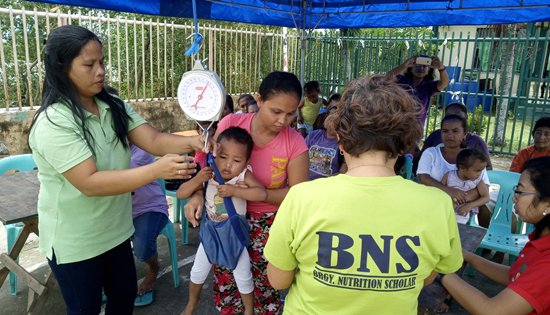
By
RAY GASPAY
June 11, 2018
CATBALOGAN CITY –
Copy-paste. This was the issue found and concern aired by the
Municipal Nutrition Action Officers (MNAOs) of Babatngon and
Capoocan, both of Leyte province, to media during the 2-day Media
Caravan conducted on June 7-8, 2018 by the Harmonized Initiative of
Media for the Spread of Good Nutrition in Region 8 (HIMSOG-8), a
media arm of the National Nutrition Council 8.
“We do not believe that we
are in the top rank of a municipality with a high prevalence of
malnutrition in the region. We see the ‘copy-paste’ practice of some
of our BNSs (Barangay Nutrition Scholars) as the culprit of this
erroneous result in the OPT (Operation Timbang)”, lamented the MNAOs
during the open forum of the media visit.
The MNAOs argued that some
of their BNSs, because of the urgency to submit their Barangay OPT
result before the deadline, tend to copy the previous year’s OPT
result, consequently providing a wrong data entry with a higher rate
of malnutrition.
When media asked that they
should tell their BNS to conduct the weighing and growth monitoring
activity with diligence, they claim that still some of their BNSs
needs more training to perform the task well. Capoocan MNAO admitted
that it is hard for her to demand better performance to her BNSs
because they only received a minimal amount of P100-P300 a month
honorarium from their barangay, and that her municipality cannot
provide them additional pay.
In the 2017 Prevalence of
Malnutrition result, Babatngon and Capoocan ranked 1 and 2 in the
prevalence of stunting rate, ranked 29 and 92 in the prevalence of
wasted and severely wasted, ranked 1 and 98 in the prevalence of
underweight and severely underweight, and ranked 25 and 6 in the
prevalence of overweight and obesity, all respectively from out of
134 municipalities in the region.
The HIMSOG-8 media caravan
is an annual activity of the regional media group to visit selected
municipalities in the region whose aim is to encourage LGUs to
invest more and enhance its programs on nutrition. It is also a
forum where issues of concern are discussed in detail, resolved or
referred to the concerned office or officials for an immediate
action.
This year’s caravan
centers more on eight (8) nutritionally depressed municipalities in
the region.
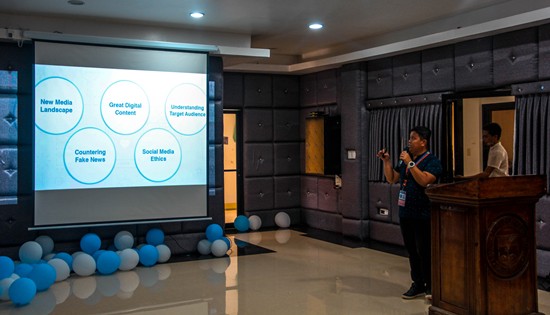
Randy
Columbres, PIO staff of DPWH-RO 8, discusses the new
strategy for countering fake news. |
DPWH PIOs combat
fake news
By
BON JOSEPH N. ASTILLA
June 11, 2018
CALBAYOG CITY – In
response to the proliferation of fake news, DPWH Public Information
Officers (PIOs) from all over Region VIII tackle countermeasures and
new media during their 2nd quarterly meeting cum workshop in
Borongan City, Eastern Samar on June 7-8, 2018.
Besides from the usual
news prints and radio broadcasts, there’s a new media that is
changing the way people across the world are entertained and consume
information. These are blogs, virtual reality, online newspapers,
digital games and the most popular, social media.
With more than 4 billion people using the internet for an average of
6 hours per day, going digital has become an essential part of
everyday life for most. Unfortunately, this is also how fake news
easily spreads.
Two years ago, “fake news” was not a term many people used but as of
today, is seen as a threat. “Fake news is actually disinformation
wherein the information is false and the person who is disseminating
it knows it is false” said Mr. Randy Columbres, PIO staff of DPWH-Regional
Office. It is an intentional lie.
As part of the strategy, PIOs are tasked to curate content in the
dissemination of information. Curated content is searchable,
reader-friendly, and potentially engaging because it showcases
variety of thoughts and ideas melded into a central platform.
In this way, misinformation and disinformation will be avoided and
it will safeguard the truth.
Traffic survey:
aid for better road design
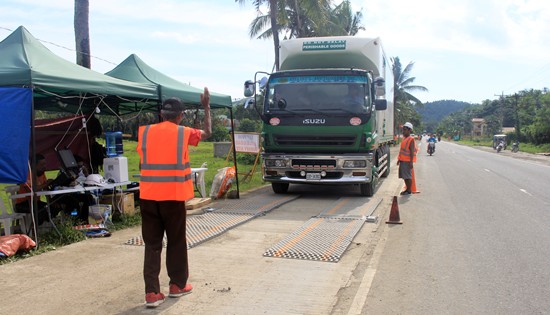
By
MAE ANGELICA R. COMOTA
June 11, 2018
CALBAYOG CITY – The
Department of Public Works and Highways -Samar First District
Engineering Office with the Regional Office No. 8 - Road Traffic
Information Applications (RTIA) Coordinator conducted the Annual
Axle Load Survey along Daang Maharlika in Brgy. Cagsalaosao,
Calbayog City. The survey period started from June 3 to 9, 2018.
Axle load is the total
weight transmitted to the road by wheels connected to the axle of a
vehicle. The axle load survey establishes load distribution and
accurate forecast on traffic loading that a road will have to carry
over its entire design life.
Traffic flow in the
above-mentioned road section was normal as the load axle survey uses
a new weighing motion scale allowing loaded trucks to be weighed
without disrupting the motorists using the same road section.
A loaded truck rolls on
the weighing scale while the attached monitor records the truck’s
gross weight and axle load. The survey team also takes note of the
truck’s plate number, number of seats, and load capacity.
The raw data collected
will be submitted to the Regional Office for consolidation. Then,
the consolidated data will be sent to the Central Office to
determine the average axle load. If the average axle load is
determined to be higher than established parameters, the thickness
of the pavement will be revised to accommodate the change in axle
load experience by the road.
Currently, the nationwide
standard of thickness for pavement design is 28 centimeters.
“With Calbayog City’s
recent economic developments, the infrastructure needs to keep up.
This survey comes at an opportune time as it will help us design and
build better roads for the public,” said District Engineer Alvin
Ignacio.
|
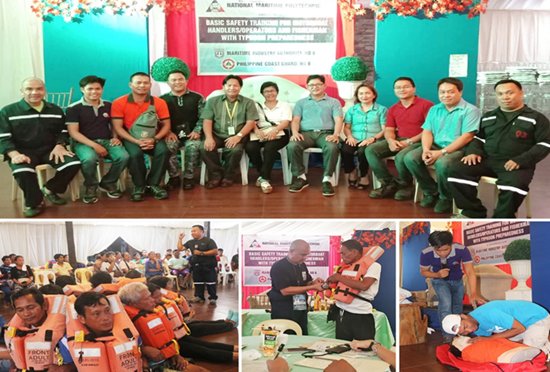
Motorboat
handlers/operators and fisherfolks participate in the Basic
Safety Training for MBHOF conducted by NMP in cooperation
with PCG, MARINA and the LGU of Abuyog, Leyte. |
156 motorboat
handlers /operators /fisherfolks receive free training from NMP
Press Release
June 8, 2018
TACLOBAN CITY – The
National Maritime Polytechnic (NMP), as part of its poverty-free
zone program thrust, conducted for free, the Basic Safety Training
for Motorboat Handlers /Operators /Fisher folks with Typhoon
Preparedness (MBHOF) to one hundred fifty-six (156) motorboat
handlers /operators /fisher folk’s participants on 04-05 June 2018
at the Judgebar Restobar, Victory, Abuyog, Leyte. The training was
held in partnership with the Philippine Coast Guard (PCG) and the
Maritime Industry Authority (MARINA) Regional Office VIII.
The training was conducted
taking in cognizant of the fact that maritime incidents and loss of
lives are sometimes attributed to accidents involving marginalized
vessels and motorboats, thus, the NMP, PCG, MARINA R.O VIII, and the
local government of Abuyog realized the need to optimize its
resources and harmonize its efforts to enhance the basic safety
skills of the residents of Abuyog – motorboat handlers /operators
and fisher folks to promote safety of life at sea.
The Basic Safety Training
for MBHOF is aimed at improving the basic safety skills of local
motorboat operators and fisher folks and expose them to new
techniques in Personal Survival, Fire Prevention and Firefighting,
Elementary First Aid and Personal Safety and Social Responsibility.
Other salient topics are Rules of the Road, Typhoon Awareness and
Marine Safety Requirements.
This was the first batch
of graduates produced by NMP on MBHOF this year. Coordination with
other LGUs in the region is currently being made for possible
collaboration, thereby expanding the reach of beneficiaries for this
program.
The MBHOF training is in
conformity with the NMP Course Plan as approved by the Board of
Trustees on 19 March 2007.
Meanwhile, NMP continues
to upgrade its facilities and provide maritime trainings required
pursuant to the Standards of Training, Certification, and
Watchkeeping for Seafarers (STCW) Convention as amended in 2010
including value-adding courses towards improving the qualifications
of Filipino seafarers for their employment acceptability and
enhanced competitiveness.
Those interested to take
NMP training programs may visit the NMP website (www.nm.gov.ph) and
its facebook page (www.facebook.com/nmptrainingcenter) where all
related information on NMP trainings are available.
|
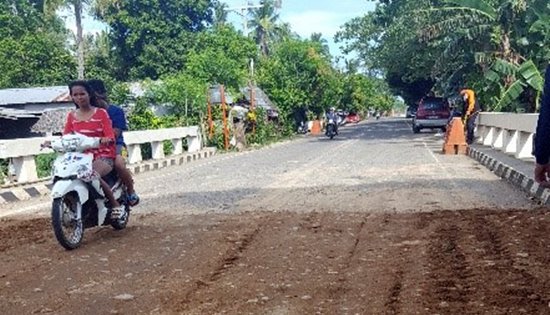
Santol
Bridge along Biliran-Naval Road Section, Brgy. San Isidro,
Biliran, DPWH Biliran District Engineering Office (DEO) is
now preparing for the Program of Works (POW) for the
restoration not only of the Santol Bridge Abutment but also
of other bridges with damaged approaches and slope
protection. |
P64.9M fund
allocated for the repair of damaged national roads and bridges in
Biliran caused by typhoon Urduja
Press Release
June 6, 2018
NAVAL, Biliran –
The Department of Public Works and Highways (DPWH)- Biliran District
Engineering Office (DEO) received P64.9M to repair/restore damaged
national roads and bridges in the province caused by typhoon Urduja.
David P. Adongay Jr.,
District Engineer said that the budget will be charged against the
Disaster-Related and Emergency Rehabilitation Fund including
National Bridges under the year 2018 General Appropriation Act (GAA),
Republic Act (R.A) 10964.
“P49.1M is allocated for
the repair/ restoration of 12 Bridge abutments and P15.8M for the
repair/ restoration of six slope protections along the national
road,” said Adongay.
Biliran is one of the
severely hit areas in Eastern Visayas Region during the onslaught of
tropical storm Urduja on December 15-16, 2017 due to landslides and
floods.
According to Adongay,
preparation of Program of Works (POW) and Plans for the repair of
said typhoon-damaged infrastructures is now on-going.
Slope Protection Structure
subject for repair/ restoration are located at Sitio Cabradilla,
Brgy. Bato, Biliran, Biliran along Biliran Circumferential Road (BCR);
Slope protection along BCR, Brgy. Bato, Biliran, Biliran; Slope
Protection along Naval-Caibiran Cross Country Road (NCCR)
Cabadiangan Detour, Naval, Biliran; Slope Protection along NCCR,
Macalpe, Brgy. Cabibihan, Caibiran, Biliran; and two Slope
protections along BCR, Mokalbukal, Catmon, Naval, Biliran.
Subject for the repair/
restoration of bridge abutments are the Santol Bridge, Moog Bridge,
and Busali Bridge at Biliran, Biliran; Mapuyo Bridge, Madao Bridge,
Ungali Bridge and Tucdao Bridge at Kawayan, Biliran; Mapula Bridge
and Mainit Bridge at Caibiran, Biliran, Talibong Bridge and Balaquid
Bridge at Cabucgayan, Biliran and Bagongbong Bridge at Almeria,
Biliran.
Adongay revealed that
construction for the new CarayCaray Bridge and Catmon Bridge at
Naval, Biliran will be included in the district’s 2019 project
implementation.
It can be recalled that
said bridges were badly damaged during the onslaught of typhoon
Urduja. These are among the major bridges that connects the province
to mainland Leyte.
The Province of Biliran is
one of the country’s smallest provinces with a land area of 536
square kilometers and a population of 171,612 as of 2015. Formerly a
sub-province of Leyte, it became an independent province in 1992.